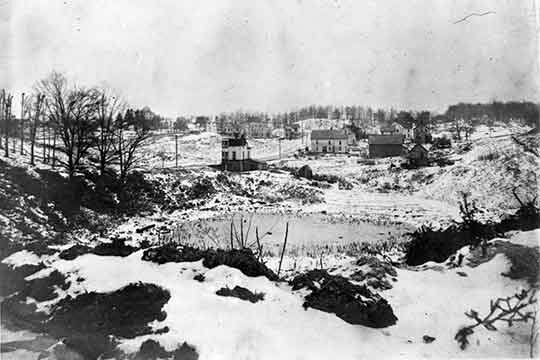M go boo (the sequel)
Ann Arbor is idyllic in many respects, but don’t let its serene façade fool you — especially this time of year. To get creeped out by campus history, look no further than this slideshow from the Bentley Historical Library. (Text by Lara Zielin and Rob Havey)
-
Devil in disguise
Gruesome posters at U-M’s Bentley Historical Library document the old-school ritual of “rush” — not a sedate round of Greek sociables, but semi-violent warfare instigated by rowdy young men in warpaint. First the battles took place between the “Lits,” “Laws,” and “Medics,” then, increasingly, between freshmen and sophomores. This is a group of “captured freshmen,” from the College of Engineering in about 1911. Rush ruled from the Civil War to World War I — in the later years, on “Black Friday” in early October.
-
A complex life
Jack Kevorkian, known in the popular media as “Dr. Death,” graduated from U-M’s Medical School with a degree in clinical pathology in 1952. His views on death and dying got him ejected from U-M’s residency program and continued causing controversy throughout his career. His archive, which came to the Bentley Historical Library this year, showcases many sides of a complex life, including music he composed and art he created, including this image titled “Nearer My God to Thee.”
-
Anything but perfect
In 1923, members of U-M’s Zeta Beta Tau fraternity included Richard A. Loeb, one half of a pair that would attempt to plan the “perfect murder” soon after this image was taken. Loeb and his counterpart, Nathan Leopold Jr., kidnapped and murdered 14-year-old Bobby Franks in Chicago in May 1924. Leopold left his glasses at the crime scene, effectively leading police right to them. The pair was sentenced to life in prison. Loeb was killed in jail in 1936. Leopold was paroled in 1958.
-
Unexpected find
Workers unearthed a cache of bones while constructing an addition to the Harrison M. Randall Laboratory in 1993. Human femur bones were found, prompting students to speculate mass murder plots, human sacrifices, and ancient Native American burial grounds. The reality, no less gruesome, is that staff in the U-M Medical School disposed of cadavers in the area during the late 19th century. After some archaeological analysis, the bones were placed in a series of 95-gallon drums and laid to rest in a local cemetery.
-
Favorite murder?
The murder trial of Dr. Hawley Harvey Crippen was a media sensation in 1910 London. Crippen, a Michigan native and U-M Homeopathy school alum, was charged with poisoning and dismembering his wife. Police found a “hunk of scarred torso” in the basement of Crippen’s home. He was convicted and hanged just a few months later. Forensic tests more than 100 years later comparing mitochondrial DNA samples of Crippen’s wife and her living descendants were shown not to match, casting doubt on the verdict. In the intervening years the Crippen story has continued to fascinate, especially in Britain. It is said to have been Alfred Hitchcock’s “favorite” murder.
-
Role reversal
“Papa Doc” Duvalier was a burgeoning political star when he came to U-M in 1944. He was appointed as the top public health official in his native Haiti soon after he left Ann Arbor and in no time worked his way to become President for Life in 1957. From there his track record for saving lives took a turn, as his oppressive regime was responsible for the death of 30,000 Haitians.
-
What’s in a name?
How did the Cat-hole, a marshy ravine northeast of the Diag, get its name? No one knows for sure, but a popular theory posits that medical students would dispose of the corpses of their surgical practice animals in the ditch, which is a short walk from the Medical School. The Cat-hole was eventually filled in and the land used for the Power Center and parking lot for the School of Dentistry.
-
The thing
These women of the Martha Cook residence hall in 1923 provide many great costume ideas for U-M students today. Want a high-concept duo costume? Try pumpkin pie before and after (top left). Are you an art student low on creativity? Try using grease paint to draw on a mustache and wear some pants (middle row center and right). Have a white nightgown and want to look terrifying? Look no further than the papier-mâché … thing in the front row.









